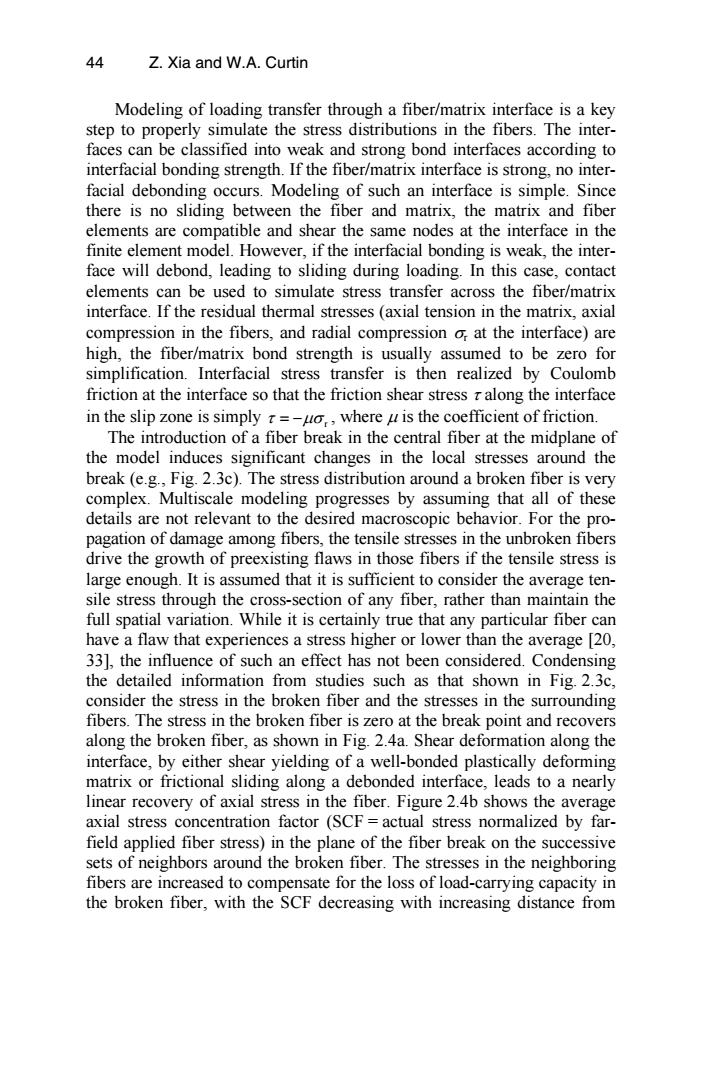正在加载图片...

44 Z.Xia and W.A.Curtin Modeling of loading transfer through a fiber/matrix interface is a key step to properly simulate the stress distributions in the fibers.The inter- faces can be classified into weak and strong bond interfaces according to interfacial bonding strength.If the fiber/matrix interface is strong,no inter- facial debonding occurs.Modeling of such an interface is simple.Since there is no sliding between the fiber and matrix,the matrix and fiber elements are compatible and shear the same nodes at the interface in the finite element model.However,if the interfacial bonding is weak,the inter- face will debond,leading to sliding during loading.In this case,contact elements can be used to simulate stress transfer across the fiber/matrix interface.If the residual thermal stresses (axial tension in the matrix,axial compression in the fibers,and radial compression o,at the interface)are high,the fiber/matrix bond strength is usually assumed to be zero for simplification.Interfacial stress transfer is then realized by Coulomb friction at the interface so that the friction shear stress r along the interface in the slip zone is simply =-uo,where u is the coefficient of friction. The introduction of a fiber break in the central fiber at the midplane of the model induces significant changes in the local stresses around the break (e.g.,Fig.2.3c).The stress distribution around a broken fiber is very complex.Multiscale modeling progresses by assuming that all of these details are not relevant to the desired macroscopic behavior.For the pro- pagation of damage among fibers,the tensile stresses in the unbroken fibers drive the growth of preexisting flaws in those fibers if the tensile stress is large enough.It is assumed that it is sufficient to consider the average ten- sile stress through the cross-section of any fiber,rather than maintain the full spatial variation.While it is certainly true that any particular fiber can have a flaw that experiences a stress higher or lower than the average [20, 33],the influence of such an effect has not been considered.Condensing the detailed information from studies such as that shown in Fig.2.3c, consider the stress in the broken fiber and the stresses in the surrounding fibers.The stress in the broken fiber is zero at the break point and recovers along the broken fiber,as shown in Fig.2.4a.Shear deformation along the interface,by either shear yielding of a well-bonded plastically deforming matrix or frictional sliding along a debonded interface,leads to a nearly linear recovery of axial stress in the fiber.Figure 2.4b shows the average axial stress concentration factor (SCF=actual stress normalized by far- field applied fiber stress)in the plane of the fiber break on the successive sets of neighbors around the broken fiber.The stresses in the neighboring fibers are increased to compensate for the loss of load-carrying capacity in the broken fiber,with the SCF decreasing with increasing distance fromModeling of loading transfer through a fiber/matrix interface is a key step to properly simulate the stress distributions in the fibers. The interfaces can be classified into weak and strong bond interfaces according to interfacial bonding strength. If the fiber/matrix interface is strong, no interfacial debonding occurs. Modeling of such an interface is simple. Since there is no sliding between the fiber and matrix, the matrix and fiber elements are compatible and shear the same nodes at the interface in the finite element model. However, if the interfacial bonding is weak, the interface will debond, leading to sliding during loading. In this case, contact elements can be used to simulate stress transfer across the fiber/matrix interface. If the residual thermal stresses (axial tension in the matrix, axial compression in the fibers, and radial compression σr at the interface) are high, the fiber/matrix bond strength is usually assumed to be zero for simplification. Interfacial stress transfer is then realized by Coulomb friction at the interface so that the friction shear stress τ along the interface in the slip zone is simply r τ = −µσ , where µ is the coefficient of friction. The introduction of a fiber break in the central fiber at the midplane of the model induces significant changes in the local stresses around the complex. Multiscale modeling progresses by assuming that all of these details are not relevant to the desired macroscopic behavior. For the propagation of damage among fibers, the tensile stresses in the unbroken fibers drive the growth of preexisting flaws in those fibers if the tensile stress is large enough. It is assumed that it is sufficient to consider the average tensile stress through the cross-section of any fiber, rather than maintain the full spatial variation. While it is certainly true that any particular fiber can the detailed information from studies such as that shown in Fig. 2.3c, consider the stress in the broken fiber and the stresses in the surrounding fibers. The stress in the broken fiber is zero at the break point and recovers along the broken fiber, as shown in Fig. 2.4a. Shear deformation along the interface, by either shear yielding of a well-bonded plastically deforming matrix or frictional sliding along a debonded interface, leads to a nearly linear recovery of axial stress in the fiber. Figure 2.4b shows the average axial stress concentration factor (SCF = actual stress normalized by farfield applied fiber stress) in the plane of the fiber break on the successive sets of neighbors around the broken fiber. The stresses in the neighboring fibers are increased to compensate for the loss of load-carrying capacity in the broken fiber, with the SCF decreasing with increasing distance from 44 Z. Xia and W.A. Curtin have a flaw that experiences a stress higher or lower than the average [20, break (e.g., Fig. 2.3c). The stress distribution around a broken fiber is very 33], the influence of such an effect has not been considered. Condensing